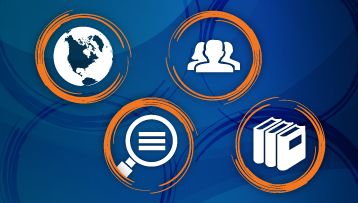TERMIUM Plus®
The Government of Canada’s terminology and linguistic data bank.
ORBITAL DEBRIS [7 records]
Record 1 - internal organization data 2006-03-20
Record 1, English
Record 1, Subject field(s)
- Launching and Space Maneuvering
Record 1, Main entry term, English
- launch window
1, record 1, English, launch%20window
correct, officially approved
Record 1, Abbreviations, English
Record 1, Synonyms, English
Record 1, Textual support, English
Record number: 1, Textual support number: 1 DEF
A limited period of time during which the launch of a particular spacecraft may be undertaken. 2, record 1, English, - launch%20window
Record number: 1, Textual support number: 1 CONT
For launches into Earth orbit the main constraints are the desired orbit, the point of injection into that orbit, and the possibility of a collision with other orbiting spacecraft or orbital debris. For launches to interplanetary trajectories, the time of launch is constrained by the relative positions of the planets, at the time of both launch and encounter(i. e. the spacecraft must be aimed at a point in space that the planet will have reached by the time of encounter). A spacecraft launched outside the launch window would require more propellant and/or more time to reach its target. 2, record 1, English, - launch%20window
Record number: 1, Textual support number: 1 OBS
There are also geometric windows (e.g., restrictions in launch azimuth). 3, record 1, English, - launch%20window
Record number: 1, Textual support number: 2 OBS
launch window: term officially approved by the RADARSAT-2 Terminology Approval Group (RTAG). 4, record 1, English, - launch%20window
Record 1, French
Record 1, Domaine(s)
- Lancement et manœuvres dans l'espace
Record 1, Main entry term, French
- fenêtre de lancement
1, record 1, French, fen%C3%AAtre%20de%20lancement
correct, feminine noun, officially approved
Record 1, Abbreviations, French
Record 1, Synonyms, French
- fenêtre de tir 2, record 1, French, fen%C3%AAtre%20de%20tir
feminine noun
Record 1, Textual support, French
Record number: 1, Textual support number: 1 DEF
Intervalle de temps pendant lequel le lancement [d'un engin spatial] permettant de réaliser une mission donnée peut-être effectué à tout instant. 3, record 1, French, - fen%C3%AAtre%20de%20lancement
Record number: 1, Textual support number: 1 OBS
fenêtre de lancement : terme uniformisé par le Groupe de travail de la terminologie de RADARSAT-2 (GTTR). 4, record 1, French, - fen%C3%AAtre%20de%20lancement
Record 1, Spanish
Record 1, Textual support, Spanish
Record 2 - internal organization data 2005-11-01
Record 2, English
Record 2, Subject field(s)
- Titles of International Programs
- Surveillance, Detection and Reconnaissance (Military)
- Spacecraft
Record 2, Main entry term, English
- Space Surveillance Network
1, record 2, English, Space%20Surveillance%20Network
correct, United States
Record 2, Abbreviations, English
- SSN 2, record 2, English, SSN
correct, United States
Record 2, Synonyms, English
Record 2, Textual support, English
Record number: 2, Textual support number: 1 OBS
Mission : Space surveillance is a critical part of USSPACECOM's mission and involves detecting, tracking, cataloging and identifying man-made objects orbiting Earth, i. e. active/inactive satellites, spent rocket bodies, or fragmentation debris. Space surveillance accomplishes the following : Predict when and where a decaying space object will re-enter the Earth's atmosphere; Prevent a returning space object, which to radar looks like a missile, from triggering a false alarm in missile-attack warning sensors of the U. S. and other countries; Chart the present position of space objects and plot their anticipated orbital paths; Detect new man-made objects in space; Produce a running catalog of man-made space objects; Determine which country owns a re-entering space object; Inform NASA whether or not objects may interfere with the space shuttle and Russian Mir space station orbits. 2, record 2, English, - Space%20Surveillance%20Network
Record 2, Key term(s)
- United States Space Surveillance System
Record 2, French
Record 2, Domaine(s)
- Titres de programmes internationaux
- Surveillance, détection et reconnaissance (Militaire)
- Engins spatiaux
Record 2, Main entry term, French
- Space Surveillance Network
1, record 2, French, Space%20Surveillance%20Network
correct, masculine noun, United States
Record 2, Abbreviations, French
- SSN 1, record 2, French, SSN
correct, masculine noun, United States
Record 2, Synonyms, French
Record 2, Textual support, French
Record number: 2, Textual support number: 1 OBS
Depuis plusieurs décennies, les États-Unis disposent d'un réseau de surveillance spatiale (Space Surveillance Network (SSN), contrôlé par le United States Space Command) qui leur permet de repérer, de suivre, de cataloguer et d'identifier tous les objets de plus de 10 cm qui se trouvent en orbite terrestre, en s'intéressant plus particulièrement aux satellites opérationnels. 2, record 2, French, - Space%20Surveillance%20Network
Record 2, Key term(s)
- Réseau de Surveillance spatiale
- Réseau de Surveillance spatiale des États-Unis
Record 2, Spanish
Record 2, Textual support, Spanish
Record 3 - internal organization data 2003-06-23
Record 3, English
Record 3, Subject field(s)
- Astrochemistry and Cosmochemistry
- Astrophysics and Cosmography
- Spacecraft
Record 3, Main entry term, English
- autonomous space processor for orbital debris
1, record 3, English, autonomous%20space%20processor%20for%20orbital%20debris
correct
Record 3, Abbreviations, English
- ASPOD 1, record 3, English, ASPOD
correct
Record 3, Synonyms, English
Record 3, Textual support, English
Record number: 3, Textual support number: 1 CONT
The project is named the Autonomous Space Processor for Orbital Debris(ASPOD) and is a NASA/Universities Space Research Association(USRA) sponsored design project. The development of ASPOD and the students’ abilities in designing and building a prototype spacecraft are the ultimate goals of this project. This year's focus entailed the development of a secondary robotic arm and end-effector to work in tandem with an existent arm in the removal of orbital debris. The new arm features the introduction of composite materials and a linear drive system, thus producing a light-weight and more accurate prototype. The main characteristic of the end-effector design is that it incorporates all of the motors and gearing internally, thus not subjecting them to the harsh space environment. Furthermore, the arm and the end-effector are automated by a control system with positional feedback. This system is composed of magnetic and optical encoders connected to a 486 PC via two servo-motor controller cards. Programming a series of basic routines and sub-routines has allowed the ASPOD prototype to become more autonomous. The new system is expected to perform specified tasks with a positional accuracy of 0. 5 cm. 2, record 3, English, - autonomous%20space%20processor%20for%20orbital%20debris
Record 3, French
Record 3, Domaine(s)
- Astrochimie et cosmochimie
- Astrophysique et cosmographie
- Engins spatiaux
Record 3, Main entry term, French
- processeur spatial autonome pour débris orbitaux
1, record 3, French, processeur%20spatial%20autonome%20pour%20d%C3%A9bris%20orbitaux
masculine noun
Record 3, Abbreviations, French
- ASPOD 1, record 3, French, ASPOD
masculine noun
Record 3, Synonyms, French
Record 3, Textual support, French
Record 3, Spanish
Record 3, Textual support, Spanish
Record 4 - internal organization data 2002-06-20
Record 4, English
Record 4, Subject field(s)
- Orbital Stations
Record 4, Main entry term, English
- redundant pressure pane
1, record 4, English, redundant%20pressure%20pane
correct, officially approved
Record 4, Abbreviations, English
Record 4, Synonyms, English
Record 4, Textual support, English
Record number: 4, Textual support number: 1 CONT
CEO [Crew Earth Observations] is conducted primarily from the nadir-viewing, optical-quality window in the U. S. Destiny Laboratory Module. The window can view 39. 5 degrees forward along the axis of the Station, 32. 2 degrees aft, and a total of 79. 1 degrees from port to starboard. The window is constructed of four panes. The outermost pane, made of fused silica, is designed to withstand orbital debris and can be changed out by extravehicular activity(EVA) if it becomes damaged. The two center panes, also made of fused silica, are the primary and redundant pressure panes. The interior pane, made of glass laminate, is called the scratch or "kick" pane. This pane protects the primary pressure pane from scratches and damage caused by contact with the crew, and has an ultraviolet/infrared(UV/IR) coating to protect the crew and improve picture quality. 2, record 4, English, - redundant%20pressure%20pane
Record number: 4, Textual support number: 1 OBS
The two middle panes [the redundant pressure pane and the primary pressure pane] serve as the primary and secondary pressure windows, ensuring that the laboratory module stays pressurized. Each of the panes is 31.75 cm (1-1/4 in.) thick. 3, record 4, English, - redundant%20pressure%20pane
Record number: 4, Textual support number: 2 OBS
redundant pressure pane: term officially approved by the International Space Station official approval Group (ISSOAG). 4, record 4, English, - redundant%20pressure%20pane
Record 4, French
Record 4, Domaine(s)
- Stations orbitales
Record 4, Main entry term, French
- deuxième vitrage du hublot
1, record 4, French, deuxi%C3%A8me%20vitrage%20du%20hublot
proposal, masculine noun, officially approved
Record 4, Abbreviations, French
Record 4, Synonyms, French
Record 4, Textual support, French
Record number: 4, Textual support number: 1 OBS
deuxième vitrage du hublot : terme uniformisé par le Groupe de travail de la terminologie de la Station spatiale internationale (GTTSSI). 1, record 4, French, - deuxi%C3%A8me%20vitrage%20du%20hublot
Record 4, Spanish
Record 4, Textual support, Spanish
Record 5 - internal organization data 2002-05-17
Record 5, English
Record 5, Subject field(s)
- Launching and Space Maneuvering
Record 5, Main entry term, English
- orbit propagation model
1, record 5, English, orbit%20propagation%20model
correct
Record 5, Abbreviations, English
Record 5, Synonyms, English
Record 5, Textual support, English
Record number: 5, Textual support number: 1 CONT
Such models combine a traffic model, a breakup model, and an orbit propagation model to predict possible future orbital debris population states. 2, record 5, English, - orbit%20propagation%20model
Record 5, French
Record 5, Domaine(s)
- Lancement et manœuvres dans l'espace
Record 5, Main entry term, French
- modèle de propagation d'orbite
1, record 5, French, mod%C3%A8le%20de%20propagation%20d%27orbite
correct, masculine noun
Record 5, Abbreviations, French
Record 5, Synonyms, French
Record 5, Textual support, French
Record number: 5, Textual support number: 1 DEF
Extrapolation, à partir de données diverses, des orbites suivantes. 1, record 5, French, - mod%C3%A8le%20de%20propagation%20d%27orbite
Record 5, Spanish
Record 5, Textual support, Spanish
Record 6 - internal organization data 2002-04-29
Record 6, English
Record 6, Subject field(s)
- Astronautics
Record 6, Main entry term, English
- Meteroid and space debris terrestrial environment reference model
1, record 6, English, Meteroid%20and%20space%20debris%20terrestrial%20environment%20reference%20model
correct
Record 6, Abbreviations, English
- MASTER 1, record 6, English, MASTER
correct
Record 6, Synonyms, English
Record 6, Textual support, English
Record number: 6, Textual support number: 1 CONT
During the development of the ESA Meteoroid and Space Debris Terrestrial Environment Reference Model(MASTER), an explosion intensity parameter B was introduced to fit the fragment mass distribution observed in ground tests and orbital breakups. 2, record 6, English, - Meteroid%20and%20space%20debris%20terrestrial%20environment%20reference%20model
Record 6, French
Record 6, Domaine(s)
- Astronautique
Record 6, Main entry term, French
- modèle de référence sur les météorites et les débris
1, record 6, French, mod%C3%A8le%20de%20r%C3%A9f%C3%A9rence%20sur%20les%20m%C3%A9t%C3%A9orites%20et%20les%20d%C3%A9bris
correct, masculine noun
Record 6, Abbreviations, French
Record 6, Synonyms, French
Record 6, Textual support, French
Record 6, Spanish
Record 6, Textual support, Spanish
Record 7 - internal organization data 2001-07-04
Record 7, English
Record 7, Subject field(s)
- Space Physics
Record 7, Main entry term, English
- natural space environment
1, record 7, English, natural%20space%20environment
correct, officially approved
Record 7, Abbreviations, English
Record 7, Synonyms, English
Record 7, Textual support, English
Record number: 7, Textual support number: 1 CONT
The natural space environment refers to the environment as it occurs independent of the presence of a spacecraft; thus, it includes both naturally occurring phenomena such as atomic oxygen(AO) and atmospheric density, ionizing radiation, plasma, etc., and a few man-made factors such as orbital debris. 2, record 7, English, - natural%20space%20environment
Record number: 7, Textual support number: 1 OBS
natural space environment: term officially approved by the International Space Station official approval Group (ISSOAG). 3, record 7, English, - natural%20space%20environment
Record 7, Key term(s)
- space environment
Record 7, French
Record 7, Domaine(s)
- Physique spatiale
Record 7, Main entry term, French
- environnement spatial naturel
1, record 7, French, environnement%20spatial%20naturel
correct, masculine noun, officially approved
Record 7, Abbreviations, French
Record 7, Synonyms, French
Record 7, Textual support, French
Record number: 7, Textual support number: 1 CONT
Environnement spatial (naturel et artificiel). Modèle de rayonnements cosmiques galactiques. 2, record 7, French, - environnement%20spatial%20naturel
Record number: 7, Textual support number: 1 OBS
environnement spatial naturel : terme uniformisé par le Groupe de travail de la terminologie de la Station spatiale internationale (GTTSSI). 3, record 7, French, - environnement%20spatial%20naturel
Record 7, Spanish
Record 7, Textual support, Spanish
Copyright notice for the TERMIUM Plus® data bank
© Public Services and Procurement Canada, 2024
TERMIUM Plus®, the Government of Canada's terminology and linguistic data bank
A product of the Translation Bureau
Features
Language Portal of Canada

Access a collection of Canadian resources on all aspects of English and French, including quizzes.
Writing tools

The Language Portal’s writing tools have a new look! Easy to consult, they give you access to a wealth of information that will help you write better in English and French.
Glossaries and vocabularies

Access Translation Bureau glossaries and vocabularies.
- Date Modified: